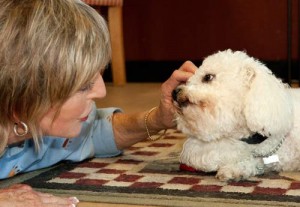Running a boarding kennel, my whole world revolves around knowing and teaching staff about the early warning signs of dog health issues. My colleagues in the business do the same. Some dog owners, however, prefer to let their dogs stay in their home while they travel, and ask a friend or relative to watch their precious pets. Do you and your friends know the early warning distress signs of canine emergencies?
Here is a check-list of emergency symptoms for you and your dog-watcher. I’m sure there are more, but these are what quickly come to mind. These symptoms do not necessarily mean a dog is in trouble, however they should be a “heads-up” for closer attention. And WHEN IN DOUBT, CALL THE VET!
I am limiting this list to potential emergency conditions that would require immediate vet attention, as opposed to chronic long-term conditions that can await your return if you are away and your dog is in someone else’s care.
Rapid, Violent Sneezing / Tilted Head or Head-Shaking
This could indicate a lodged foxtail, either in the nose, or in the ear. Foxtails need immediate removal, as these nasty things can work their way into your dog’s body and either come out somewhere else on the animal (like through a leg or paw), or travel to vital organs. The latter can be fatal.
- Excessive Water Drinking
- Attempts to Vomit
- Extended, Tight Abdomen
- Drooling
- Diarrhea
- Loss of Appetite
- Standing with Legs Splayed
- Resistance to Move
- Generally Looking Miserable.
Collectively, these are potential signs of canine bloat or gastric torsion, related conditions that can kill a dog within hours if not treated! Your dog’s stomach has either expanded with excess gas, or has actually twisted on itself. Immediate vet attention is needed to save your dog’s life if this is a case of bloat/torsion. First aid while you are loading up your dog for his ride to the vet can be a dose of an anti-gas product, like Mylanta, especially if your dog’s stomach is filling with gas. Keep it handy, along with a small plastic dosing syringe.
Drooling and Swallowing
This could be nothing, or it could indicate your dog is in the early stages of an allergic reaction and his throat is swelling shut. This type of allergic reaction, though rare, is similar to what humans can experience if they are allergic to bee stings, shellfish, etc. The throat swelling can be immediate, or it can be a delayed reaction to an exposure days earlier to something uniquely toxic to your dog, so it sneaks up on you unexpectedly. Be vigilant.
Temperature Over 102.5
The normal temperature for a dog is 100.5 to 102.5. The most accurate temperature is taken rectally, with a baby thermometer and Vaseline as lubricant. If a dog does not seem himself, and his temperature is 103 or over, he needs to be seen by a vet. There can be many reasons for an elevated temperature, but none of them good. When a dog’s temperature goes above 105, there is also the risk of life-threatening organ damage. Keep a thermometer and Vaseline in your canine first aid kit.
Pale Gums and Tongue
This is never good. Pale, gray-ish gums or tongue can indicate shock or something else affecting your dog’s circulation or it can mean that your dog is bleeding internally. Get your dog to a vet immediately!
Sudden Loss of Appetite or Repeated Vomiting of Meals
This could be nothing more than nervous reaction to a change in environment, or it can indicate something much more serious, including a blockage in the GI tract. Dogs eat everything, especially things they shouldn’t – rocks, tennis balls, toys. Recently, I had a dog dropped off at my kennel who refused to eat. I did not worry until the third day, thinking he was just depressed from being away from home. On the third day he refused even the filet mignon I had bought to tempt him. His temperature was normal and his gums and tongue were nice and pink, but I took him to the vet anyway. X-rays revealed a corn cob lodged in his intestines and he was rushed into emergency surgery! The owner suspects he got into the garbage the day before he came to the kennel, during a play day with one of his doggie friends.
The best prevention is preparation. Learn the warning signs of canine distress and teach others. Your dog could owe you (or them) his life.
-Diva










